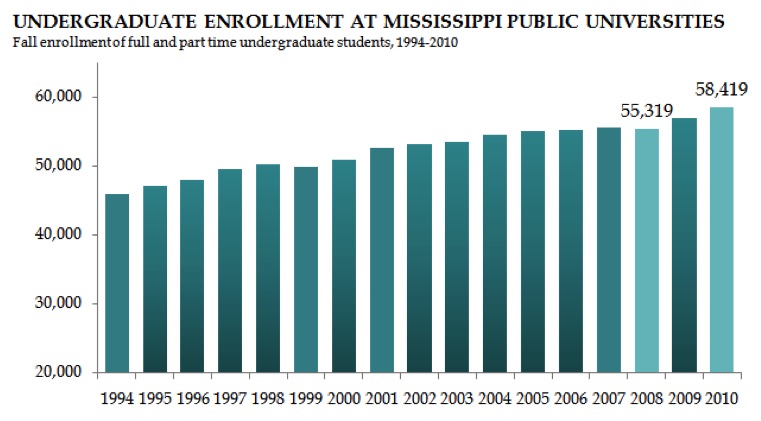Do Mississippi Universities Have Enough Resources to Build Up the State’s Workforce?
August 26th, 2011
Sid Salter’s column calls attention to a developing funding trend among the state’s public universities. Institutions of Higher Learning, like Mississippi State University, are increasingly looking to private giving to help address the financial strain that comes when limits in state funding and growing student attendance converge. The column notes that “The troubling part of that budget reality is that the cuts are coming at a time of increased enrollment as students head back to universities to get new skills in the new economy after the prolonged recession.”
More and more, students return to university campuses with the hope of increasing skills, earning a degree, and moving into higher wage employment. As high school graduates and adults pursued courses, university enrollment experienced a particularly strong uptick between 2008 and 2010. From the fall of 2008 to the fall of 2010, Mississippi’s public universities enrolled an additional 3,100 undergraduate students, the largest real increase in students among the years charted. See Chart.
Click to enlarge
Enrolling more students puts increased demand on a university’s faculty, administrative staff, infrastructure and classroom, library, and dormitory space. Inadequate funding of universities can force schools to pass costs on to students through tuition, over half of which already need to take out student loans to finance their education.[i]
While a challenging funding environment for universities persists, leaders across Mississippi are seeking ways to increase the number of higher wage, higher skill employment opportunities in the state. Increasing such opportunities will mean that employers, workers, and community leaders will depend on the post-secondary education system to meet industry and workforce needs.
The increasing demands set on the state’s university system need to be met with adequate resources. The knowledge that public universities are increasingly turning to private giving to make ends meet underscores the importance of taking a balanced approach that includes raising revenue instead of a cuts-only approach that constrains education systems in a time of growing need.
Author:
Sarah Welker, Policy Analyst






